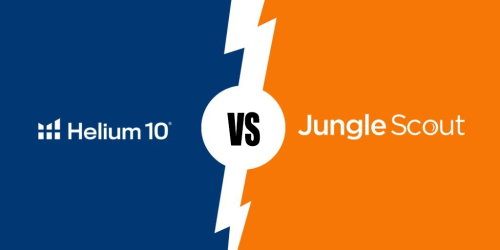How to Do Amazon FBA Product Research Using Jungle Scout | FULL Tutorial
Finding a winning product can feel impossible if you’re guessing. The truth? Winners are found with a repeatable, data-driven system—not by “gut feel.”
In this guide I’ll walk you through the exact 3-step Jungle Scout workflow I use to go from zero ideas to a validated product you can launch with confidence:
Click here to get 30% off Jungle Scout!
- Product Discovery (endless viable ideas on demand)
- Data Analysis (validate demand, competition, and profit)
- Differentiation (create a real competitive advantage)
💡 I used this same process to spot a winning product idea in under 10 minutes. You can, too—if you follow the steps and filters below exactly.
Step 1 — Product Discovery (Build a Pipeline of Viable Ideas)
You won’t “think up” enough good ideas from scratch. You need a system that feeds you candidates every time you sit down to research.
Use Jungle Scout → Product Database
- Product Research → Product Database
- Marketplace: United States (or your target marketplace)
- We’ll set smart filters that most beginners don’t use so you can surface niches others miss.
Categories to Target (and Avoid)
I focus on evergreen, lower-risk categories. I avoid categories with high liability, many variations, or breakage risk.
| Prefer | Why |
|---|---|
| Home & Kitchen, Patio/Lawn/Garden, Tools, Sports & Outdoors, Industrial/Scientific, Automotive (non-electronic accessories) | Evergreen demand, fewer compliance pitfalls, good improvement opportunities |
| Avoid | Why |
|---|---|
| Clothing/Shoes/Jewelry | Size/color variations → high returns, complex inventory |
| Cell Phones & Electronics | High breakage, complex manufacturing, harder to differentiate |
| Grocery/Beauty/Health | Ingestibles/liability/compliance |
| Toys & Games | Heavily restricted, trend-driven, short product life cycles |
Product Size & Weight
- Product Tier: Standard size only
- Weight: ≤ 2 lb (keeps FBA fees, shipping, and storage sane)
Core Filters That Actually Matter
Use these as a starting point. You will tweak them as you hunt.
| Filter | Suggested Setting | Why |
|---|---|---|
| Price | $30 – $80 | Avoid low-price races, support higher profit |
| Monthly Units Sold (Min) | 300 | Indicates real demand (translates to ~$1.5K–$3K/mo profit with $5–$10 margin) |
| Monthly Revenue | $6,000 – $18,000 | Targets solid niches without stepping into big-brand kill zones |
| Reviews (Max) | 300 | Keeps competition manageable |
| Seller Type | All | Captures the full landscape |
| Exclude Top Brands | ✅ | Reduce noise from brand-driven sales |
| Exclude Keywords | Add your “no thanks” terms (see below) | Filters out clutter (e.g., apparel, food, name brands) |
Exclude Keywords (starter list):
men, women, kids, shirt, pants, bra, jeans, dress, nike, under armour, nba, food, snack, lotion, cream, serum, supplement
🔁 Save Your Searches. Create several saved filter sets (e.g., “$20–$35”, “$35–$60”, “$60–$90”) and rotate through them. You’ll consistently surface fresh ideas.
Pro Browsing Tactics That Save Time (and Find Hidden Gems)
- Set page size to 100 results.
- Start from the last page and work backwards (everyone else starts at page 1).
- Look for “What is that?!” If you instantly recognize it, it’s usually too competitive.
- Don’t deep-dive yet. Star interesting items; you’ll validate them in Step 2.
Step 2 — Data Analysis (Validate Demand, Competition, Profit)
Discovery finds products. Analysis validates the niche behind each product idea so you don’t chase mirages.
2.1 Confirm the Right Main Keyword
Everything hinges on analyzing the correct search term.
- Go to Amazon, set All Departments, and search the term you think is primary (e.g., tent stakes).
- Scan the first page: Are most listings the same product type you want to sell?
- If not, refine the term (e.g., screw-in tent stakes instead of generic tent stakes).
Optional validation:
Use Jungle Scout → Keyword Scout → paste up to 10 ASINs from top organic results → sort by Search Volume. Your main keyword should appear at/near the top.
⚠️ Don’t analyze the wrong keyword. You’ll be validating the wrong market.
2.2 Pull Real Market Data (Chrome Extension)
- Open the search results for your main keyword.
- Launch Jungle Scout Chrome Extension → Scan Search Results.
- Important:
- Don’t sort by columns. Keep the organic order (that’s your competition).
- Hide Sponsored in filters (SP icon) to remove ad noise.
2.3 The “Go/No-Go” Checklist
Use this simple table to quickly judge the niche. Look at the top 15–20 organic listings (not the averages box).
| Factor | Target | How to Check | Why It Matters |
|---|---|---|---|
| Competition (Reviews) | Majority < 300 | Count reviews of top 15–20 | Lower barrier to rank and convert |
| Demand (Units) | Majority ≥ 300/mo | Monthly Sales column | Real velocity supports your launch |
| Revenue | Majority ≥ $6K/mo | Revenue column | Enough dollars to hit profit goals |
| Price Point | $30–$80 | Price column | Supports healthy margins |
| Listing Age | ≤ 4–5 new in top 20 | Date First Available | Avoid “new seller swarm” niches |
| Brand Dominance | No brand with 3–4+ spots in top 20; no mega brands | Brand names in top 20 | Prevents brand-loyalty headwinds |
| Seasonality | Non-seasonal or mild | Sales/BSR history graph (2 years) | Year-round sell-through is safer |
✅ If the majority passes these thresholds, keep going.
❌ If two or more fail hard, move on. Time is your most valuable asset.
2.4 Validate Profit (Before You Fall in Love)
Margins beat vanity metrics every time.
- In the Chrome Extension, click Net Profit on a few top listings.
- Enter realistic COGS and shipping-to-FBA estimates (use Alibaba quotes for ballparks).
- Confirm you can hit ~30–40% margin at the market price, not wishful thinking.
🧮 No Jungle Scout? Use Amazon’s free FBA Revenue Calculator to ballpark fees and net.
2.5 Catch the “Gotchas” Early
- Niche saturation: Many “Date First Available” within last ~90 days → new-seller stampede.
- Price cliffs: Some niches split into $10–$15 “cheap” vs $30–$40 “premium.” Analyze the right segment (e.g., screw-in tent stakes vs tent stakes).
- Compliance/Restrictions: Patents, trademarks, gated categories, and product safety. (Do a quick patent & category policy scan before you invest further.)
Step 3 — Differentiation (How You Win After You Validate)
Once a niche passes Step 2, you still need a compelling reason for shoppers to choose you.
3.1 Let Reviews Tell You What to Build
Open the top 5–10 competitors and run Jungle Scout → Review Analysis (AI summary):
- Extract common complaints: quality issues, parts that bend/break, installation pain, missing accessories, poor storage/case, unclear instructions, etc.
- Aggregate across multiple listings (don’t base decisions on one product).
- Turn complaints into upgrades: stronger materials, reinforced parts, tool-less install, bonus accessory, better case, QR-code video instructions, warranty, etc.
3.2 Bundle Intelligently
Check “Frequently Bought Together” and top-selling complementary items:
- Add a high-perceived-value accessory that solves a pain point.
- Keep it lean (don’t tank margins with heavy/expensive add-ons).
3.3 Craft a Clear Value Proposition
Your final concept should answer, in one line:
“Compared to the top sellers, mine solves X pain with Y improvement, plus Z bonus—for about the same price.”
If you can’t write that sentence clearly, your differentiation isn’t ready yet.
Bonus: Use Jungle Scout Opportunity Finder for Trend-Led Ideas
Where Product Database surfaces products, Opportunity Finder surfaces rising keywords so you can spot markets before they get crowded.
Click here to get 30% off Jungle Scout!
Settings to start with:
- Categories: Same short-list you used for Product Database
- Monthly Units, Price, Exclusions: Mirror Product Database
- Competition: Very Low–Low
- Seasonality: Very Low–Low
- Exclude Top Brands: ✅
Hit Search and scan the list for “wait… what is that?” niches (e.g., shampoo sheets / soap paper tins). Then send candidates through Step 2 (full validation). Avoid fads with hyper-spiky curves (think fidget spinners).
Working Example (From the Transcript)
Generic tent stakes looked promising at first—but prices clustered under $10 → no margin. By pivoting to screw-in tent stakes, the price floor jumped near $30, revenue was strong, and reviews were manageable. That’s the kind of micro-niche shift that turns a “no” into a “go.”
Your Repeatable Research Workflow (One-Pager)
Use this checklist every session:
- Discovery
- Load a saved Product Database filter.
- Browse back-to-front, star 5–10 odd/unique products.
- Keyword Confirmation
- Identify the main keyword from titles and Keyword Scout.
- Niche Validation (top 15–20 organic)
- Reviews: majority < 300
- Units: majority ≥ 300/mo
- Revenue: majority ≥ $6K/mo
- Price: $30–$80 cluster
- Age: ≤ 4–5 new in top 20
- Brands: no dominance/mega brands
- Seasonality: stable
- Profit Math
- 30–40% margin at market price (with realistic COGS + freight + FBA fees).
- Differentiation
- Review Analysis → convert complaints → features/bundle.
- Write your one-line value prop.
- Kill Fast / Move Fast
- If 2+ core criteria fail, kill and move on.
- If it passes, proceed to supplier outreach and sample testing.
Filter & Criteria Cheat Sheet (Copy/Paste)
Product Database (baseline):
- Price: $30–$80
- Monthly Units (min): 300
- Revenue: $6,000–$18,000
- Reviews (max): 300
- Size Tier: Standard
- Weight: ≤ 2 lb
- Exclude Top Brands: On
- Exclude Keywords: (add your list)
Opportunity Finder (baseline):
- Competition: Very Low–Low
- Seasonality: Very Low–Low
- Price: $30–$80
- Exclude Top Brands: On
- Then validate with the full Step-2 checklist.
FAQ — Quick Wins & Common Mistakes
Q: Should I cap “Sellers” in filters?
A: No. Total sellers is irrelevant. Only the top page competitors matter.
Q: Can I chase ultra-high revenue niches?
A: That’s where big brands live (and ad CPCs spike). Start with $6K–$18K/mo and expand later.
Q: What about 5-star products only?
A: Try the opposite. Set Star Rating max 3.5–4.0 to find products that sell despite issues you can fix.
Q: How do I avoid PPC bloodbaths?
A: Stay out of hyper-competitive keywords. Your filters + review caps + age checks reduce that risk up front.
What to Do Next
- Run Product Database with the filters above.
- Shortlist 5–10 ideas you don’t instantly recognize.
- Validate each with the Go/No-Go checklist.
- For the winners, use Review Analysis to blueprint your differentiation.
If you follow this workflow exactly, you’ll stop guessing and start building a repeatable product pipeline—the difference between a one-off win and a real Amazon business.
Quick Reference Tables
A. Go/No-Go Thresholds
| Metric | Pass If… |
|---|---|
| Reviews (majority, top 20) | < 300 |
| Monthly Units (majority) | ≥ 300 |
| Monthly Revenue (majority) | ≥ $6,000 |
| Price Cluster | $30–$80 |
| New Listings in Top 20 | ≤ 4–5 |
| Brand Dominance | None (no brand with 3–4+ in top 20) |
| Seasonality | Low (stable graph across the year) |
| Profit Margin | ≥ 30% at market price |
B. Differentiation Ideas From Reviews
| Common Complaint | Upgrade / Solution |
|---|---|
| Bends/breaks under load | Stronger alloy, thicker gauge, reinforced design |
| Pulls out of ground | Screw-in design, deeper threads, wider helical profile |
| Hard to install | Include driver/socket, ergonomic handle, quick-start card |
| Poor carry case | Rigid case, better zippers, dedicated slots |
| Rust/corrosion | Anodized or coated finish, stainless hardware |
| Confusing instructions | QR video, visual one-pager, multilingual icons |
Final Word
You don’t need luck. You need a system.
- Product Database to feed ideas
- Chrome Extension to validate niches
- Keyword Scout to verify the head term
- Review Analysis to design a better offer
Click here to get 30% off Jungle Scout!
Run the play, kill losers quickly, and double down on winners. That’s how you build momentum—and a catalog that compounds.






